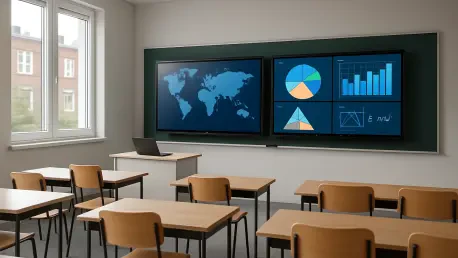Ghana’s push to retool classrooms for a digital-first future found a proving ground in Tamale, where Ghana Senior High School (Ghanasco) unveiled a Katon360-powered smart classroom complex that stitched together infrastructure, devices, content management, and support into a single working system that targeted everyday teaching and learning pain points rather than chasing glossy gadgets. The moment carried weight: the project was framed by President John Dramani Mahama at the school’s 65th anniversary as part of a wider reset of instruction, equity, and skills. That framing mattered because it set expectations beyond a one-off ribbon cutting, positioning the complex as both a functional upgrade for Ghanasco and a signal of how Ghana could scale digital literacy, modernize the curriculum, and stabilize learning continuity despite grid and connectivity constraints.
Inside The Smart Classroom Build
The centerpiece is a two-story block built to operate as a cohesive learning platform, not just a series of rooms with screens. Ten smart classrooms share a backbone of solar power, climate control, and reliable charging, mitigating grid volatility that can torpedo momentum mid-lesson. Each room integrates a smart screen and companion tools that allow teachers to blend live explanation with pre-uploaded media, switch formats on the fly, and keep lessons consistent across classes. Surrounding spaces—technical room, dedicated charging and repairs rooms, a lecture hall, and auxiliary areas—do more than add square footage; they institutionalize upkeep and workflow so scheduling, device care, and content staging become routine rather than ad hoc triage.
Equally critical is the one-to-one device model that underpins a blended pedagogy. Every student receives a tablet with a three-year life cycle, preloaded with core materials that work in class and after hours. Teachers can push content in advance, queue assessments, and pace modules so instruction continues even when a teacher steps out or a timetable shifts. Katon360 folds in Kanton Meet to extend lessons, staff meetings, and guest sessions beyond the campus, supporting continuity during disruptions and widening access to expertise. While connectivity quality still varies, the model reduces dependence on a perfect link by making much of the learning package available offline, then syncing when the signal stabilizes.
Safety, Focus, And Responsible Use
Robust management is a defining choice: tablets ship with trackers and filters that prioritize academic content and block unauthorized sites, explicitly social media, reflecting a school-centered approach that addresses persistent parental concerns. This is not a blanket prohibition so much as a timetable for attention, where content policies keep the learning day uncluttered while leaving room for age-appropriate exploration within a safe envelope. The goal is to protect study time and uphold classroom norms without turning devices into dull terminals that students are eager to evade, a balance reinforced by reminders from President Mahama about intent and responsibility.
Governance extends to data and usage patterns, which the platform corrals to support teaching rather than surveil for its own sake. Administrators can see which modules stall, where lag affects participation, and how pacing correlates with performance, helping staff refine lesson design without offloading the burden onto teachers after hours. At the same time, the school’s emphasis on responsible use sets a cultural baseline: the devices are tools, not toys, and their value flows from daily habits—charging, care, and attention. That tone helps limit misuse while preserving student agency, a middle path that many schools struggle to maintain when policy swings from permissive to punitive.
Early Signals And National Trajectory
Early feedback from classrooms is pragmatic rather than breathless. Teachers report sharper engagement, faster preparation via pre-uploaded slides and simulations, and smoother handoffs when a colleague covers a session, with smart boards summarizing lessons and anchoring continuity. A physics teacher’s account tracks with global findings: when content is staged and screens become collaborative surfaces, students participate more evenly and drift less. The recurring constraint is connectivity, which can slow updates or live sessions, but the architecture blunts that impact by caching materials. Students, meanwhile, describe learning as more accessible and enjoyable, aided by the Katon360 app and timely support from facilitators.
Beyond Ghanasco, the project sat at the intersection of equity and scale. As the second Katon360 facility—and the first in the northern region—it positioned the school as a testbed for a rollout that could standardize access to devices, content, and maintenance. The design choices—solar power, district technicians, charging rooms, and a clear repair policy—spoke to durability rather than spectacle, addressing the common failure point where devices decay without support. As policy signaled an equity-first push, the model offered next steps: continue hardening connectivity, invest in teacher training aligned to blended pedagogy, ring-fence maintenance funding, and link usage analytics to curriculum reviews. Framed that way, the initiative marked a credible path forward rather than a one-time upgrade.









